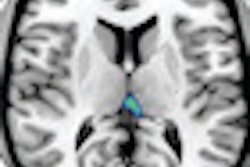DCE-MRI can be used to assess microvascular characteristics in head and neck cancer patients without radiation exposure and can be a potential biomarker for tumor biology.
MRI offers "superb contrast resolution, lack of ionizing radiation as compared with CT perfusion, and continuous sampling of data for more than four minutes, allowing the assessment of washout," said study co-author Yoshimi Anzai, MD. Matakazu Furukawa, MD, PhD, a visiting researcher at the University of Washington, will present the study results.
DCE-MRI was performed in 14 patients with head and neck tumors; this included eight cases of malignant lesions, three cases of benign tumors, and three cases with postradiation changes. In addition, 11 lymph nodes in seven patients were analyzed separately.
After a bolus injection of contrast, a DCE-MRI study was performed using a T1-weighted fast-field echo sequence on a 3-tesla MRI system. Between 2,000 and 3,000 dynamic images were obtained for up to 6.5 minutes. Data analysis was performed using quantitative analysis of T1 perfusion. Time to peak (TTP) and brevity of enhancement (BE) were evaluated quantitatively.
The mean TTP of malignant tumors, benign tumors, and postradiation changes were 155 (± 68), 54 (± 39), and 250 (± 64), respectively. TTP was significantly longer in the malignant tumors compared with the benign tumors.
Although TTP was longer in the postirradiated malignant tumors (n = 3; 198 ± 51) compared to malignant tumors without radiation (n = 5; 129 ± 67), the finding did not reach statistical significance due to the small number of patients.
Regarding brevity of enhancement, malignant tumors had a significantly longer BE (211 ± 75) than benign tumors (122 ± 12). TTP was significantly longer in pathologic lymph nodes (142 ± 80) with lower peak enhancement than in benign lymph nodes (43 ± 19).
The clinical benefit of the findings is that they give physicians the ability to differentiate postradiation changes from recurrent tumors in previously irradiated patients. "This needs further evaluation in a larger cohort of patients," Anzai said.
The researchers plan to continue this study in oncology. "Based on what we learned from this retrospective study, we are planning to do a prospective study," Anzai added.



















